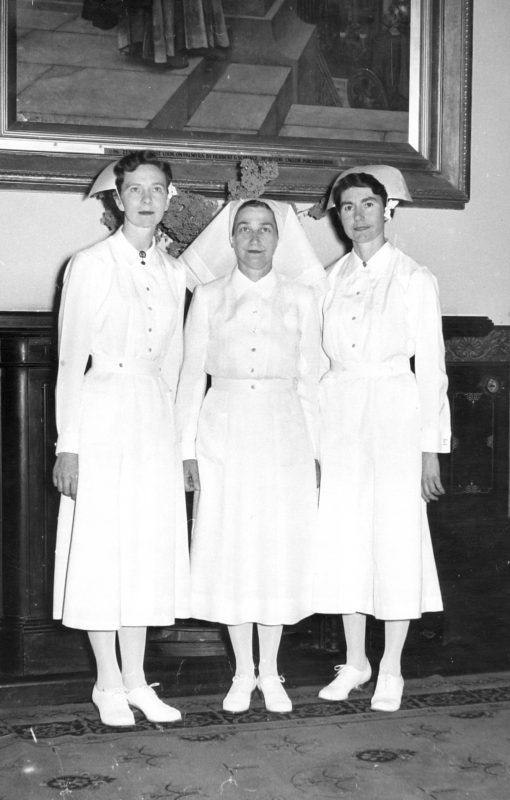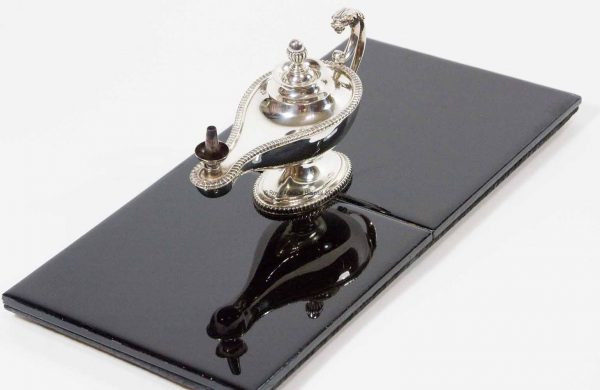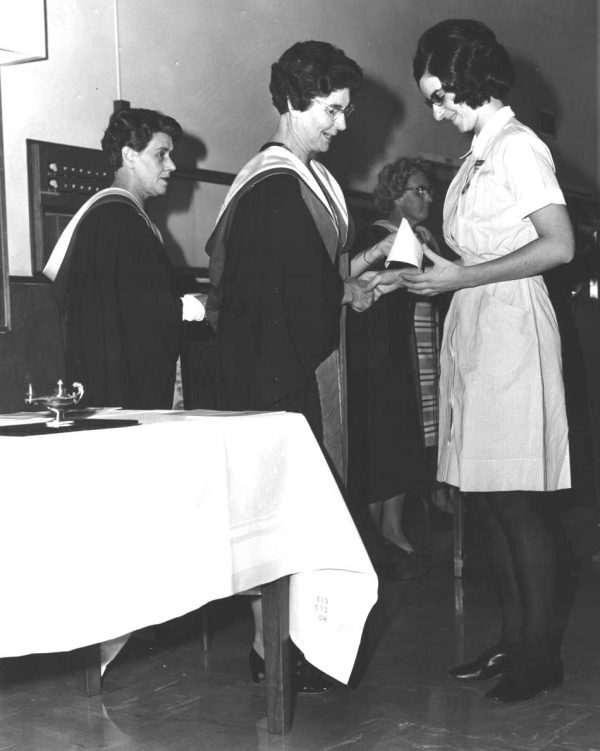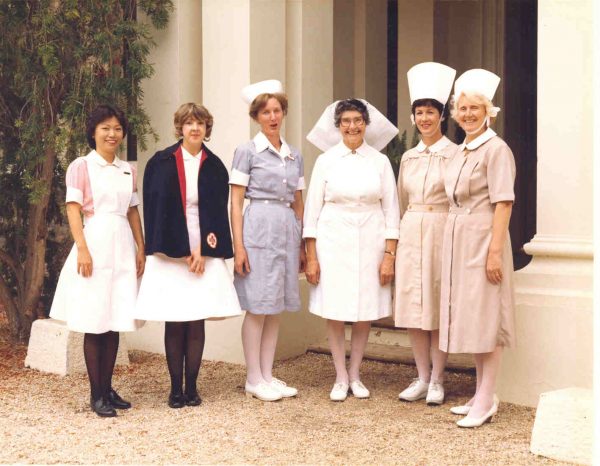Irene Mary Kennedy, Superintendent of Nurses, Royal Adelaide Hospital, 1966 – 1973 (retirement)
Irene Kennedy was raised in Adelaide, South Australia. Her nursing career started at the Adelaide Hospital in 1933. The following paragraphs are taken from the eulogy at the Memorial Service For Irene Kennedy, Royal Adelaide Hospital Chapel, 31/07/1991, by Joan Durdin.
Irene’s training was undertaken when conditions for nurses were tougher than they are today.
‘Let us trace her career, see what she brought to nursing, and what legacy she left. Irene’s training was undertaken when conditions for nurses were tougher than they are today. The forty-eight-hour week had not yet been introduced. There was a curfew for residents in the Nurses’ Home, and all light went out at 11pm. Lectures were few and far between. Irene had the misfortune to arrive at the hospital when the Home Sister, who usually gave some lectures, was on leave. When Irene appeared before the relieving Home Sister, expecting to attend class, she was curtly told that the Home Sister had better things to do than to give lectures. Nurses taught each other, and Irene was gratified to learn, many years later, that one of her colleagues still had a little notebook, which Irene had made for her as a birthday present in her first year of training, a book which contained lists of all the treatment trays that nurses needed to set up in the ward.
As a young registered nurse Irene did midwifery, then worked at the Port Lincoln Hospital, at the Mercy Hospital, in Melbourne, and at Calvary Hospital in North Adelaide. In 1945 she returned to the Royal Adelaide Hospital as one of the two nurses to staff the Blood Transfusion Serve. Experience during the war had led to advances in intravenous therapy and blood transfusion, and the new service at the RAH was set up to meet a growing need for a blood bank and a staff to apply the new technology. Dr Hugh Gilmore, then a medical registrar, instructed the nurses in the theory and practice needed for their new role. Possible this was the first example of in-service training for the registered nurses!
In 1947 Irene’s initial interest in teaching, and perhaps her own rather dismal experience as a student nurse in need of a teacher, led her to make application for the Florence Nightingale Scholarship. Funds for the successful applicant for the fourth award, and in the middle of 1947 she left for London to study at the Royal College of Nursing. On completion of the one year course she remained for further teaching experience in Leicester, with associates at the Leicester Infirmary gave them the lamp which today graces the altar of the chapel. After the lamp came into Irene’s possession she made it available to the school of Nursing, to be used on the occasion of capping ceremonies. It is also used by the South Australian chapter of the College of Nursing Australia, for special ceremonies. It is fitting that it is here today.
When Irene returned to the Royal Adelaide Hospital she took charge of the first preliminary training school at the hospital. Budgets were tight in those days and it was considered a great concession that nurses could receive four week’s classroom instruction in preparation for their nursing duties. An eight-hour day still had to be observed, and every hour accounted for, so the one tutor sister was fully occupied in instruction, with no time to prepare her lessons until she went home in the evenings. At the end of each month one group of students moved out and another group moved in – eleven times a year. Later the duration of the PTS extended, and the tutor was allowed a week between one intake and the next. On reflection, I don’t wonder that Irene considered moving into nursing administration after five years. In such a position she would ultimately be able to exert influence to improve the conditions under which nurses learnt.

Irene was assistant matron for three years and deputy matron for seven years, under the leadership of Miss Huppatz whom she greatly admired. Upon Miss Huppatz retirement in 1966, Irene became the superintendent of nurses. Whereas her experience in education led her to promote many changes in the education of both undergraduate and registered nurses in the following years, she never failed to acknowledge that the successful implementation of such change demanded the co-operation and the sustained efforts of the registered nurses, particularly the charge nurses. Building on the foundations laid by her predecessors, and encouraged by a forward-looking Director General of Medical Services, Irene was able to initiate long-overdue changes that brought nursing conditions and nursing education into line with other states, and contributed to improved standards of nursing care. It will be appreciated that such activities were not all accomplished within a forty-eight hour or later a four-hour working week. Irene’s flat in the Nurses Residential Wing included a room which she used as an office, where work could be done after hours, without interruption. Those of you who visited her there will recall the room, where piles of papers and plans often spilled over from the desks to the chairs to the floor.
Throughout her twenty-six years as a teacher and a nurse administrator at the Royal Adelaide Hospital, Irene was also an active member of several nursing associations, in particular the Florence Nightingale Committee, the College of Nursing, Australia, and the Australian Nursing Federation. She was secretary of the South Australian branch of the College of Nursing, and later was a member of the Education Committee and the Council of the College. In 1972 she was President of the College of Nursing and had the privilege and the responsibility of chairing the annual meeting of the College when it was held in Adelaide that year. She was an active member of the Florence Nightingale Committee until its disbandment in 1976 and represented South Australia on the National executive for several years. In 1966 she was president of the National Florence Nightingale Committee. Irene was a member of the council of the SA branch of the Australian Nursing Federation for twenty-three years, the latter years being particularly active as the organisation extended its role as a professional and industrial body for nurses.

The lamp was given to Irene Kennedy by Matron Nell Savage, on her retirement. Miss Kennedy donated it to Royal Adelaide Hospital to be used on ceremonial occasions. 
The lamp on the table during a capping ceremony, when nurses were presented with their cone caps at the end of a three months probationary period. Shown here from left are Deputy Matron Inez Maynard; Superintendent of Nurses Irene Kennedy, (background Sister D Clarke) and Nurse A. Posa receiving her cap.
On completion of the 12-month tutor course at the Royal College of Nursing, London, Irene, with fellow student Nell Savage, remained for further nursing experience in Leicester. (Nell Savage had served in the nursing service during World War 2 and was the only nurse to survive the hospital ship “Centaur” sinking off the Queensland coast on 14 May 1943, which was torpedoed by the Japanese).
When Sister Kennedy and Sister Savage left to return to Australia, their associates at the Leicester Infirmary gave them the lamp (featured), which was made available to the School of Nursing and used on occasions of capping ceremonies. It was also used by the South Australian chapter of the College of Nursing, Australia, for special ceremonies. (ref. Eulogy at the Memorial Service for Irene Kennedy, RAH Chapel, 31/7/91 ).
Irene Kennedy received an Order of the British Empire (O.B.E.) in 1978 for service to health and nursing administration. (ref. Supplement to the London Gazette, 30 December 1978).
